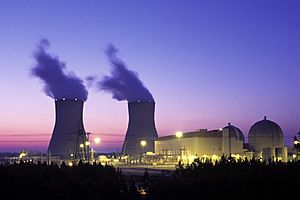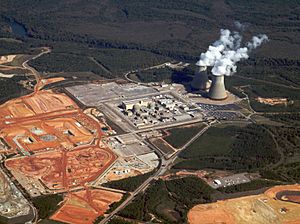Vogtle Electric Generating Plant facts for kids
Quick facts for kids Plant Vogtle |
|
|---|---|

Vogtle 1 & 2 containment buildings and cooling towers
|
|
| Country | United States |
| Location | Burke County, Georgia |
| Coordinates | 33°8′36″N 81°45′38″W / 33.14333°N 81.76056°W |
| Status | Operational |
| Construction began | Unit 1–2: August 1, 1976 Unit 3: March 12, 2013 Unit 4: November 19, 2013 |
| Commission date | Unit 1: June 1, 1987 Unit 2: May 20, 1989 Unit 3: May 2021 (planned) Unit 4: May 2022 (planned) |
| Construction cost | Units 1–2: $8.87 billion (1989 USD) ($17.1 billion in 2021 dollars ) Units 3–4: $25 billion (estimated) |
| Owner(s) | Georgia Power (45.7%) OPC (30%) MEAG (22.7%) Dalton Utilities (1.6%) |
| Operator(s) | Southern Nuclear |
| Website Plant Vogtle |
|
The Alvin W. Vogtle Electric Generating Plant, often called Plant Vogtle, is a large nuclear power plant in Burke County, Georgia. It is in the southeastern part of the United States. This plant is named after Alvin Vogtle, who used to be a leader at Southern Company.
Plant Vogtle uses special machines called Westinghouse pressurized water reactors (PWRs). These reactors help create steam, which then spins a steam turbine to make electricity. The first two units, Unit 1 and Unit 2, started working in 1987 and 1989. Together, they can produce a lot of electricity, about 2,430 megawatts.
The plant has tall cooling towers that are about 548 ft (167 m) high. These towers help cool down the water used in the plant. There are also smaller cooling towers that help keep important safety systems cool. In 2009, the plant's licenses were renewed, meaning they can keep making power until 2047 for Unit 1 and 2049 for Unit 2.
Right now, two more units, Unit 3 and Unit 4, are being built. These new units will use a modern reactor design called Westinghouse AP1000. They will also have very tall cooling towers, almost 600 ft (180 m) high. Once these new units are finished, Plant Vogtle will become the biggest nuclear power station in the United States.
Contents
How the Reactors Work
Plant Vogtle has two reactors that are already working and two more that are being built. Here is some information about them:
| Reactor Unit | Reactor Type | Power Output (MWe) | Building Started | Connected to Grid | Started Working | Shut Down | |
|---|---|---|---|---|---|---|---|
| Net | Gross | ||||||
| Vogtle-1 | Westinghouse 4-loop | 1150 | 1229 | August 1, 1976 | March 27, 1987 | June 1, 1987 | |
| Vogtle-2 | Westinghouse 4-loop | 1152 | 1229 | August 1, 1976 | April 10, 1989 | May 20, 1989 | |
| Vogtle-3 | AP1000 | 1117 | 1250 | March 12, 2013 | May 2021 (Planned) | ||
| Vogtle-4 | AP1000 | 1117 | 1250 | November 19, 2013 | May 2022 (Planned) | ||
Making More Power
In 2008, both of the first two reactors were made a little more powerful, by about 1.7%. This was done by using better ways to measure how much power the reactor was making. By measuring more precisely, the plant could safely run closer to its maximum power. This change was approved by the Nuclear Regulatory Commission (NRC) in March 2008. Unit 1 was updated in Spring 2008, and Unit 2 was updated in Fall 2008.
Power Outage Incident
On March 20, 1990, there was an incident where the plant lost some electrical power. A truck accidentally hit a support column, which cut off power to a part of Unit 1. At the time, some backup systems were also out for maintenance.
Because of this, the system that removes heat from Unit 1's reactor core stopped working. Even when a reactor is turned off, it still produces some heat that needs to be removed. Plant operators quickly worked to fix the problem. They used an emergency start system to get a backup generator working.
Power was restored, and the core temperature was brought back to normal. The plant learned from this event and made changes to its electrical systems. Now, it's easier to connect different parts of the plant's power system in an emergency. This helps make sure that vital safety systems always have power.
Unit 2 was also affected by the incident. It automatically shut down as a safety measure. However, it was later found that the safety system that caused the shutdown was set too sensitively. This was corrected to prevent similar issues in the future.
Building Units 3 and 4
The idea for two new units at Plant Vogtle started in 2006. Southern Nuclear asked for permission to build more reactors on the site. In 2008, they signed a contract to build two new AP1000 reactors designed by Westinghouse. This was a big step, as it was the first agreement for new nuclear power plants in the U.S. since 1979.
Construction Progress
Building started slowly in 2009. The new units were first expected to be ready in 2016 and 2017. However, there have been some delays and the expected completion dates are now 2021 for Unit 3 and 2022 for Unit 4.
In 2010, President Barack Obama announced that the government would help with the building costs by offering loan guarantees. The total cost for the two new reactors was first estimated at $14 billion.
In February 2012, the NRC approved the main license to build the new reactors. Some groups tried to stop the project because of safety worries after the Fukushima nuclear disaster in Japan. However, a court allowed the construction to continue.
Construction officially began on Unit 3 in March 2013, when a large concrete base was poured. Work on Unit 4's base started in November 2013. Over the years, many large parts of the reactors have been put into place. This includes big structural pieces and the main reactor vessels.
Challenges During Construction
Building these new units has faced challenges. In 2017, Westinghouse Electric Company, the main contractor, had financial problems. This caused delays and increased costs. However, the plant owners, led by Southern Nuclear, took over the construction. They hired Bechtel to manage the daily work.
In November 2017, the Georgia Public Service Commission approved the project to continue. They set conditions to help control costs. By 2018, the total cost was estimated to be about $25 billion. To keep the project going, Georgia Power agreed to help cover extra costs for its partners.
In 2019, more federal loan guarantees were given to help with financing. This brought the total federal support to $12 billion. Important steps were completed, like placing the top cap on Unit 3's containment building. This means Unit 3 is getting ready to receive nuclear fuel. Work on Unit 4 is also moving forward, learning from the experience of Unit 3.
People Living Nearby
The Nuclear Regulatory Commission has special zones around nuclear power plants for emergencies.
- The first zone is about 10 miles (16 km) around the plant. This zone is for concerns about breathing in radioactive materials.
- The second zone is about 50 miles (80 km) around the plant. This zone is for concerns about food or liquids that might be affected.
In 2010, about 5,845 people lived within 10 miles (16 km) of Plant Vogtle. About 726,640 people lived within 50 miles (80 km). The city of Augusta, Georgia, is about 26 miles (42 km) away.
Earthquake Risk
The NRC also studies the risk of earthquakes. Their estimate for Plant Vogtle is that there is a 1 in 140,845 chance each year of an earthquake strong enough to cause serious damage to a reactor. This shows that the risk is very low.
See also
 In Spanish: Planta de energía nuclear Vogtle para niños
In Spanish: Planta de energía nuclear Vogtle para niños


